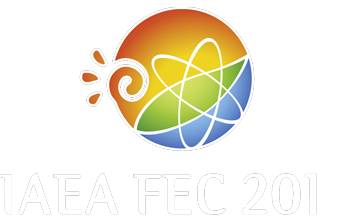Speaker
Dr
Hiroo Kondo
(Japan Atomic Energy Agency)
Description
We report the validation results of liquid lithium target stability for an intense fusion neutron source, currently being planned as the International Fusion Materials Irradiation Facility (IFMIF), the advanced fusion neutron source (A-FNS), or the DEMO oriented neutron source (DONES). Thickness variation of the Li target must be suppressed to be within 1 mm inside a deuteron beam footprint to maintain the integrity of the Li target and guarantee the desired level of neutron flux. The Engineering Validation and Engineering Design Activities (EVEDA) for the IFMIF are implemented under the Broader Approach (BA). As a major activity of the Li target facility, the EVEDA Li test loop (ELTL) was constructed by the Japan Atomic Energy Agency to validate the stability of the Li target envisaged in the IFMIF. Main validation results are (1) Average target thickness variation was just 0.17 mm inside the beam footprint under the IFMIF conditions (Target speed: 15 m/s, Vacuum pressure: 10^−3 Pa, Li temperature: 250 degree C). (2) Mean and maximum wave amplitudes were 0.26 mm and 1.46 mm, respectively, at the beam center under the IFMIF conditions. (3) 2-month long-term operation with one shutdown was performed, and the target stability was unchanged during the operation period. (4) All those results satisfied the IFMIF requirements, and the Li target stability was successfully validated. From these results, we accomplished the engineering validation of the Li target stability for IFMIF, A-FNS and DONES, and achieved a significant milestone towards the next stage of those intense fusion neutron projects.
| Country or International Organization | Japan |
|---|---|
| Paper Number | MPT/P5-11 |
Author
Dr
Hiroo Kondo
(Japan Atomic Energy Agency)
Co-authors
Dr
Eiichi Wakai
(Japan Atomic Energy Agency)
Dr
Juan Knaster
(IFMIF/EVEDA project team)
Dr
Takuji Kanemura
(Japan Atomic Energy Agency)
Mr
Tomohiro Furukawa
(Japan Atomic Energy Agency)
Mr
Yasushi Hirakawa
(Japan Atomic Energy Agency)

